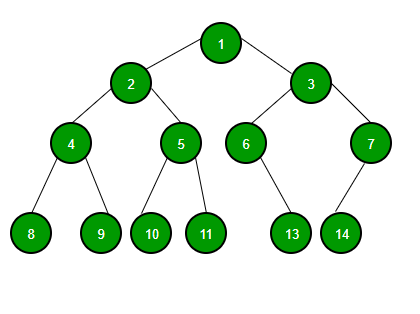What is Binary Tree?
Last Updated :
02 Mar, 2023
A binary tree is a type of tree data structure in which each node can have at most two child nodes, known as the left child and the right child. Each node of the tree consists of – data and pointers to the left and the right child.

Example of Binary Tree
Properties of a Binary Tree:
The following are some of the important properties of a binary tree:
- A binary tree allows for a maximum of two children per node.
- The maximum number of edges between the root and a leaf node determines the height of a binary tree.
- A binary tree can have a maximum of 2d nodes at depth d.
- A binary tree of height h can have a maximum of 2(h+1) – 1 nodes.
- In a binary tree, there can only be as many leaf nodes as internal nodes plus one.
To learn more about the properties of binary trees, refer to this article.
Types of Binary Trees:
There are several types of binary trees that are based on their properties-
Binary Tree based on the number of children:
Binary Tree based on the completion of levels:
To learn more about the types of binary trees refer to this article.
Applications of Binary Tree
Binary trees have a wide range of applications in computer science and other fields. Some of the common applications of binary trees include:
- Expression evaluation: In order to evaluate arithmetic expressions, binary trees are used.
- Data compression: The widely used data compression method known as Huffman coding uses binary trees to describe the frequency of characters in a message.
- Decision-making processes: Binary trees may be utilized in decision-making procedures such as game trees and decision trees.
- Network routing: To effectively route packets via a network, network routing methods use binary trees for the transfer of packet.
- Machine learning: Binary trees are utilized in machine learning techniques like decision trees and random forests to model and classify the data.
To learn more about the applications of binary trees, refer to this article.
Advantages of binary tree:
- Effective searching and sorting: Binary trees are useful in a variety of applications because they offer effective searching and sorting operations.
- Memory efficiency: Because binary trees use less memory than other tree structures like multi-way trees or linked lists, they are a viable option for huge data sets.
- Fast insertion: As we know only a portion of the tree needs to be updated therefore binary trees enable fast element insertion.
To learn more about the advantages of binary trees, refer to this article.
Disadvantages of binary tree:
- Limited structure: Binary trees can only have two child nodes per node, which can restrict their versatility and usefulness in some applications.
- Difficult to implement: It needs close attention to the node ordering and tree structure, implementing a binary tree can be difficult.
- Inefficient for some operations: Some of the operations like finding the minimum or maximum value in a binary tree, can be less efficient and require additional steps and complexity to perform.
To learn more disadvantages of binary trees, refer to this article.
What else can you read?
Share your thoughts in the comments
Please Login to comment...